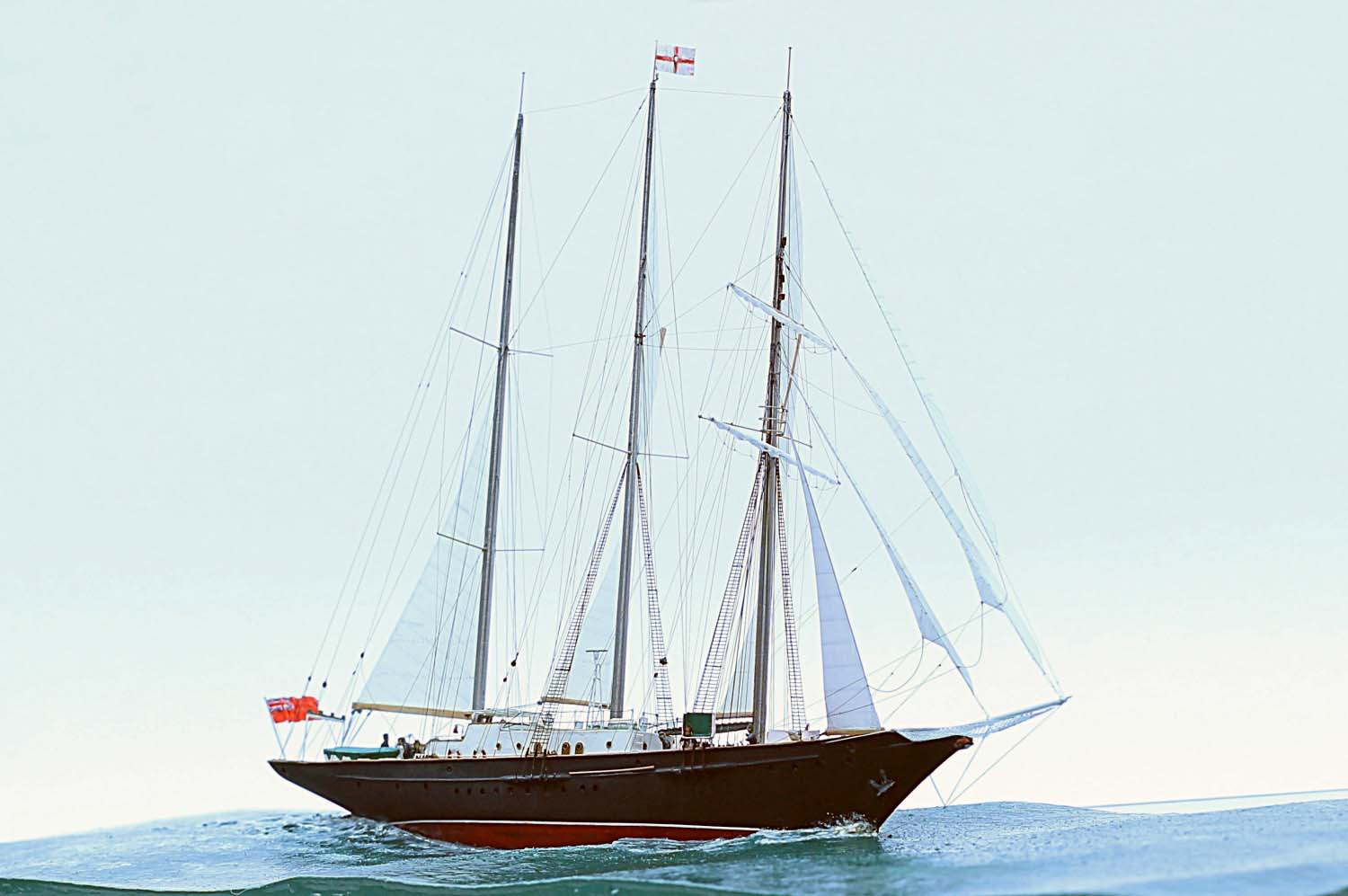
1/350 Sir Winston Churchill (Imai /scratch)
|
by Jim Baumann |

1/350 Sir Winston Churchill (Imai /scratch)
Sir Winston Churchill was built for the British Sail Training Association ( S.T.A. )She was designed as a three-masted topsail schooner with two square sails on yards,, two gaff rigged mainsails sails and a large Bermudan rigged mizzen, along with staysails, topsails and flying jibs
The idea behind this seemingly oddly jumbled style of rig was that sail training students could gain experience in handling every type of sail commonly seen on sailing ships of the 20 th Century
The 135 ft long steel hulled vessel was built by Richard Dunston of Hessel on the River Humber in 1965/66
In 1968 a sister ship, the Malcolm Miller was launched.
Sir Winston Churchill differed from Malcolm Miller mainly in having rounded top cabin door midships, whereas those of the Malcolm Miller were square topped. The Sir Winston Churchill was also somewhat lower in the water at the stern. When she was being built, the poured concrete ballast had run aft ... more than intended ...(!) This was never corrected and therefore this difference in trim can be clearly seen in most photographs of the two ships together.
She served together with the Mallcom Miller for over 34 years as the primary Sail and adventure training ships for the S.T.A. for both adults as well as youngsters.
In 1976, the vessel took part in a transatlantic Tall ships race to celebrate the Bicentenary of the United States Declaration of Independence.
The vessel was sold by the Sail Training Trust in 2000, but continued operating as a sail-training ship, albeit with reduced capacity owned by an Isle of Man based company.
In 2007 she underwent a major refit, and she now again in commission as a luxurious private Yacht under Greek flag, cruising the Mediterranean and the Aegean seas under charter .
The over 40 year old Imai kit is pretty good in hull outline , but aside from the hull and deck insert virtually everything else was discarded and fabricated from scratch. Being a fairly 'modern' sailing ship, finding information of the ship would seem to have been straightforward, but I found it not to be a simple as anticipated.
There are numerous small resolution images of the ship all over the internet mostly views from a distance with unhelpful graininess and a lack of pixels, many of which were only useful in seeing the rig outlines.
The candid photos posted in various threads on the 'net by people who had actually sailed on the vessel in her sail training days often gave good views of much of the deck detail. However the most useful source of reasonable resolution images was found by making screen-shot stills from old Pathe News cine-reels found on You-tube
Along with the 1/100 plan sheets, courtesy of David Carter . numerous views of various models in often larger scales, almost all of which conflicted in many ways with photos of the real thing!
The detailed step-by-step summary in the thread of the build can be found right here in the forum at Modelwarships.com.
The masts on the real ship were made of anodised aluminium in one piece, on the model they were made of stainless steel welding rod spun in a drill at speed and filed to shape to make a fine taper and then left unpainted .
The square section wooden spars of the real ship were made of strips of coarse thick old 00 gauge Model Railway locomotive Coupling rods
The sails were cut of fine-grained paper,with the panel lines drawn on carefully with a pencil--particular care being taken to ensure the diagonal seams and verticals of the mitre cut seams would line up correctly on both sides.
They were then varnished to make them moisture impervious The sails were then gently washed with thinned white watercolour paint to soften the appearance.
Thereafter they were rolled and shaped to induce the 'twist in the gaff, mizzen and headsails; with particular attention paid to ensure the leeches would all be parallel.
The model was set on her sea using my usual watercolour paper over wooden cocktail-sticks described here in the forum at Modelwarships.com.
Rigging this was a bit different for the first time ever for me, a mixture of my usual preferred stretched sprue , made and applied as per description here. combined with some ultra-fine 'Uschi' flexible thread used mainly for al the vertical halyards to pinrails.
In conclusion, taking in consideration the age of this venerable and quite rare kit, it was a fair starting point to make a model of this much-loved piece of 20 th Century British sailing ship history Whilst in retrospect I can see areas where I would have could have made it finer still--I am satisfied with the end result!
